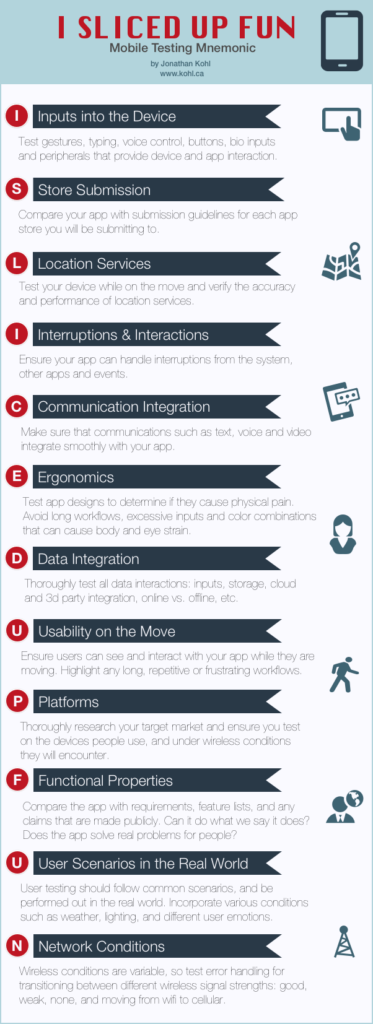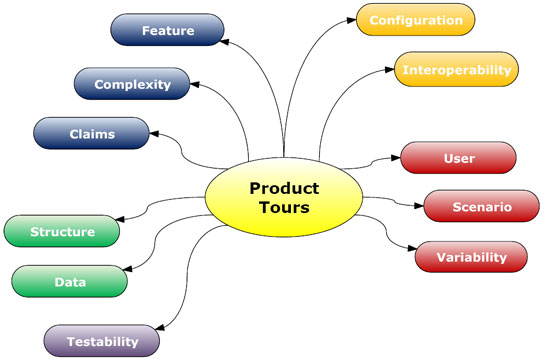Practice, Practice, Practice
To practice exploratory testing, you will find that you need to be able to generate test ideas, sometimes at a moment’s notice. The sky (or more accurately your mind) is the limit to the kinds of tests you can implement and practice with. The more you think up new tests, and learn to analyze software from many different angles, the more thorough your testing and the resulting discoveries will be. Like anything else, the more you practice, the better you will get.
Test Idea Strategies
Here are some test strategies you can use to generate test ideas to practice exploratory testing. Practice testing, but also practice thinking about testing, applying strategies and doing analysis work.
Concrete Strategies
Sometimes as a tester you need to grab and use specific test ideas off the shelf to get started quickly. Do you have a source of ideas for specific strategies tests sequences, or test inputs? Some test teams have quick reference lists with specific test ideas for their applications under test for this purpose. If you are practicing exploratory testing, and find you need some new ideas quickly, here are some places to look.
Michael Hunter has a fabulous list of test ideas in his You Are Not Done Yet blog series.
Elisabeth Hendrickson’s Test Heuristics Cheat Sheet describes “data type attacks & web tests”.
Karen Johnson has some concrete test ideas on her blog as well. Check out Testing by the Numbers, Chars, Strings and Injections, and ; SQL injections- -‘ for some ideas.
Concrete test ideas can be incredibly useful. Recently I decided to grab some of my favorite testing numbers off the shelf and input them through a test interface I had just developed (written in Java using a library which allowed me to write commands in JUnit tests.) I found a bug within seconds thanks to a testing interface that allowed me to use more speed and accuracy in my test inputs, and my off-the-shelf testing numbers.
Abstract Strategies
Abstract strategies are all about testing ideas. These require more thinking than a quick off the shelf test, but the benefits are enormous. Applying these kinds of strategies to testing can result in very thorough, creative, and disciplined test strategies and execution. You can use these strategies to help design tests in the moment, or while doing test analysis or test planning. Some examples include test models and heuristics.
James Bach’s Heuristic Risk-Based Test Strategy Model is a great place to start. In fact, James’ methodology page is full of great ideas for testers. I touched on the subject of a benefit of using models in this blog post Speeding Up Observation with Models.
Thanks to the work of James, there are several testing mnemonics you can use, or better yet, use as inspiration to create your own.
I touched on the subject of learning testing heuristics here.
Other models include coverage models, failure mode analysis, McLuhan thinking, and many others.
Language Strategies
This is another abstract strategy, but language is so important I decided to give it its own category. Examples of strategies are to look at the meaning of words, how they are put together, and how they might be interpreted in different ways. I use dictionaries a lot to help my thinking, and they can be a great tool to expose vague terms. I also use grammar rules when I investigate a product and look for potential problem areas. I engage in almost a type of “software hermeneutics.” The linguistics (study of language) field has a wealth of tools we can also use to help generate test ideas.
The requirements-based testing community have a good handle on testing written documentation. When I look at anything that is written down that has to do with the product, I carefully look at the wording. That includes in the software, in any supporting documentation, comments, tests, etc. and I look for potential ambiguities. For example, Bender RBT Inc, has a paper, the “The Ambiguity Review Process” which contains a section: “List of Words that Point to Potential Ambiguities“.
Once you find an ambiguity, can you interpret the usage of the software in different ways and test according to different definitions? This is often a surprising source of new test ideas. I use language analysis a lot as a tester, and it is a powerful method for me to generate test ideas.
Sensing and Feeling Strategies
Using Emotions
This is can include situations where our senses are telling us something that we aren’t immediately aware of. We feel a sense of discomfort, sometimes called “cognitive dissonance”. Things appear to be functioning, but we feel conflicted, sometimes for reasons that aren’t readily apparent . I’ve learned to use the “feeling that something is off” as a clue to start investigating that area much more heavily. It almost always pays off in the discovery of a good bug.
Michael Bolton describes this emotional side of testing very well:
…When I feel one of those emotional reactions, I pause and ask “Why do I feel this way?” Often, it’s because the application is violating some consistency heuristic–it’s not working as it used to; it’s not supporting our company’s image; there’s a claim, made in some document or meeting or conversation, that’s being violated; the product is behaving in a way that’s inconsistent with a comparable product; …
Update: Be sure to check out Michael’s excellent presentation on this topic here. It might change the way you think about testing.
Using Your Senses
Have you ever pushed a machine to its limits when testing and noticed something physically change in your test environment? This is also a trigger for me to push harder in that direction, because a discovery is on the way.
Here are some examples:
- sluggish response when interacting with the UI, or an API
- interaction slowing down
- sense the machine labouring
- hear the fan kick in hard when running a test
- feel the device getting hot
An old rule of thumb when traveling is to use a map, but follow the terrain. Being aware of any strange feelings you have when testing (it feels off, let’s investigate this a bit more), and being aware of changes to the test environment are great ways to explore the system.
George Dinwiddie reminded me of a good rule of thumb:
As Bob Pease (an analog EE) used to say in Electronic Design and EDN magazines, ‘If you notice anything funny, record the amount of funny.’
As a tester, when I see something funny, my first instinct is to get the application to repeat the funny behavior. Then I observe whether follow-on testing creates even more funny behavior. In many cases it does, because bugs often tend to cluster.
Some of my most significant discoveries have come about because I paid attention to a weird feeling, investigated further, noticed something flicker out of the corner of my eye, or noticed that the log file on a server that I was tailing was writing at a strange rate, or that a certain action caused my machine to start laboring, etc. It’s often the subtle things that are the biggest clues to overlooked problems in the system, so it’s a good idea to practice your observation skills.
Oblique Strategies
These are ideas you can use to spur creative thought processes if you find yourself running out of ideas. Michael Bolton introduced me to these last year while we were working on a testing exercise. I was running out of ideas, and Michael sent me to this web site that generates oblique strategies. After a couple of tries, I ended up on a whole new idea set that jump-started my testing.
Wikipedia says this about Oblique Strategies: “…is a set of published cards created by Brian Eno and Peter Schmidt. Now in its fifth edition, it was first published in 1975. Each card contains a phrase or cryptic remark which can be used to break a deadlock or dilemma situation.”
When I was a kid, my family had a game where you would blindly open a dictionary, close your eyes, and put your finger down on a page. You would then open your eyes, look at the word closest to your finger, and then make up a short story involving that word. A variation involved doing this for two words, and then combining them to try to come up with something creative or funny. This is a similar kind of idea generating strategy to oblique strategies, but not as sophisticated. There are other, similar ways of getting oneself out of a rut.
With these sorts of tools you often need to be creative to apply your result to testing, but with a little bit of trial and error and creative thinking, you will be surprised at what you come up with.
Uncategorized, or Inexplicable Strategies
Sometimes, believe it or not, some of my friends dislike my need to systematize, categorize and neologize. They prefer to think that their testing ideas are the work of intuition, or are dropped to them by the testing muse, or the idea fairy. That’s fine, and I can respect that they think about things differently. Furthermore, I frequently miss out on ideas and insights that they have. I’ve added this section to include the mysterious, the unexplained, or any other test strategy I might not be aware of, or be hard-pressed to categorize.
What works for you? Do you use a strategy for testing that I haven’t touched on in this post? This list is in no way exhaustive, and it, like any other model, is imperfect. I’m sure my own model and strategies will change as I learn more, and get more feedback from colleagues, and you, the reader.
I hope this list of test strategies helps you as you practice exploratory testing. Test idea generation can be as creative as we permit ourselves to explore, and one of the wonderful things about software testing is that sometimes the weird idea combinations are the best ones. Furthermore, practice helps build the strength and agility of the most powerful testing tool we have at our disposal, the human mind.

